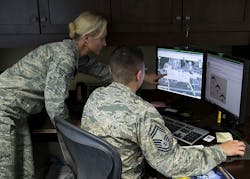Army to brief industry on artificial intelligence and machine learning for intelligence data processing
SILVER SPRING, Md. – U.S. Army researchers will brief industry later this month on a new initiative in artificial intelligence and machine learning to help the military quickly turn enormous volumes of data processing into actionable intelligence and insights.
Officials of the Army Research Laboratory in Research Triangle Park, N.C., will brief industry on 24 Oct. 2017 on artificial intelligence and machine learning as it applies to the Pentagon's Algorithmic Warfare Cross Functional Team (AWCFT).
Briefings will be from 8 a.m. to 6 p.m. on 24 Oct. 2017 at the Tommy Douglas Conference Center, 10000 New Hampshire Ave., in Silver Spring, Md. The AWCFT seeks to accelerate military integration of big data, artificial intelligence, and machine learning.
Also known as Project MAVEN, the AWCFT’s first task was to develop computer vision algorithms to help military and civilian analysts deal enormous amounts of full-motion video. Progress has been encouraging, and now the AWCFT is focusing on applying big data and machine learning against other challenging problems.
Program experts are trying to apply computer vision algorithms to data processing, exploitation and dissemination. Efforts center on developing computer vision models for wide-area motion imagery; full-motion video from tactical unmanned aircraft; using cloud computing for video processing and dissemination; index and search for model output databases; artificial intelligence interfaces; and video support for forward-deployed warfighters.
Researchers eventually want to expand a prototype from the analysis of vertical image and video to document analysis; natural language processing for machine translation and gisting; optical character recognition; horizontal still photo video object and persona identification; horizontal video object and persona identification; cognitive computing for target systems analysis and entity relationship identification; and other areas using machine learning approaches.
Army researchers are inviting all businesses engaged in artificial intelligence and machine learning to submit their capabilities. This all-day event will allow businesses to engage their counterparts, create synergy, and ask questions.
Industry briefings will focus on:
-- frameworks and tools for the creation of deep learning algorithms;
-- tailored deep learning algorithms to perform discrete tasks. in support of deep learning;
-- new methods of edge computation to bring deep learning algorithms to constrained computational environments;
-- methods to evaluate and determine the effectiveness of deep learning algorithmic approaches in a testbed environment;
-- interfaces for the display, search, and interaction with algorithmically derived metadata and tabular structured algorithmic output;
-- new techniques, hardware, software, and tools for the training, testing, and validating of deep learning algorithms; and
-- storage and indexing capabilities for local algorithmically produced data.
Companies interested should register for the industry briefings, and submit capabilities, online at www.arl.army.mil/maven/index.html.
For questions or concerns contact the Army's Bryan Hoffman by email at [email protected], or by phone at 301-394-3060. More information is online at https://www.fbo.gov/notices/5d44b79da9a9c84bf5bbd6746ebf9ca0.
Ready to make a purchase? Search the Military & Aerospace Electronics Buyer's Guide for companies, new products, press releases, and videos

